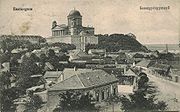
Szentgyörgymezo
Encyclopedia
Szentgyörgymező is the northern part of the city of Esztergom
in Hungary
, on the right bank of the river Danube
. It was a separate village until 1895, when it was merged with the "Royal Esztergom" as 4th district, along with neighboring Víziváros
and Szenttamás. In the northern part of Szentgyörgymező lies a military cemetery, where 604 Hungarian and 175 Austrian soldiers of the 1848 revolution
are buried. This is the biggest cemetery of the 1848 revolution.
 The "St. George's provostry" was founded by Saint Stephen. The village was first mentioned in 1230. The baroque
The "St. George's provostry" was founded by Saint Stephen. The village was first mentioned in 1230. The baroque
Roman Catholic church was built in 1785 on the site of the previous church, and the neoclassical
Miklósffy-chapel - the cemetery chapel - was built in 1835. The village itself was a property of the archbishop of Esztergom. The Reading circle was founded in the 19th century, and still functions as the cultural centre of the district. In 1854 Szentgyörgymező was merged with Esztergom for the first time, but in 1868 they were separated by the wishes of Esztergom county. In 1891 the village had 325 households and had 2698 Hungarian inhabitants. In 1895 it was merged with Esztergom for the second - and final - time as the 4th district of Esztergom. Most of the people were wine-growers, 80% of them were living from agriculture, and Szentgyörgymező has kept its rural appearance. In the 1980s ruins of 10-12th century houses were discovered and excavated. László Paskai, cardinal of Hungary, former Archbishop of Esztergom lives here.
Esztergom
Esztergom , is a city in northern Hungary, 46 km north-west of the capital Budapest. It lies in Komárom-Esztergom county, on the right bank of the river Danube, which forms the border with Slovakia there....
in Hungary
Hungary
Hungary , officially the Republic of Hungary , is a landlocked country in Central Europe. It is situated in the Carpathian Basin and is bordered by Slovakia to the north, Ukraine and Romania to the east, Serbia and Croatia to the south, Slovenia to the southwest and Austria to the west. The...
, on the right bank of the river Danube
Danube
The Danube is a river in the Central Europe and the Europe's second longest river after the Volga. It is classified as an international waterway....
. It was a separate village until 1895, when it was merged with the "Royal Esztergom" as 4th district, along with neighboring Víziváros
Víziváros
Víziváros is a neighborhood of Esztergom, Hungary on the right bank of the Danube, under the royal castle and the St. Adalbert Primatial Basilica. The name Watertown derives from the numerous hot springs in the area.-History:...
and Szenttamás. In the northern part of Szentgyörgymező lies a military cemetery, where 604 Hungarian and 175 Austrian soldiers of the 1848 revolution
Hungarian Revolution of 1848
The Hungarian Revolution of 1848 was one of many of the European Revolutions of 1848 and closely linked to other revolutions of 1848 in the Habsburg areas...
are buried. This is the biggest cemetery of the 1848 revolution.
History

Baroque
The Baroque is a period and the style that used exaggerated motion and clear, easily interpreted detail to produce drama, tension, exuberance, and grandeur in sculpture, painting, literature, dance, and music...
Roman Catholic church was built in 1785 on the site of the previous church, and the neoclassical
Neoclassical architecture
Neoclassical architecture was an architectural style produced by the neoclassical movement that began in the mid-18th century, manifested both in its details as a reaction against the Rococo style of naturalistic ornament, and in its architectural formulas as an outgrowth of some classicizing...
Miklósffy-chapel - the cemetery chapel - was built in 1835. The village itself was a property of the archbishop of Esztergom. The Reading circle was founded in the 19th century, and still functions as the cultural centre of the district. In 1854 Szentgyörgymező was merged with Esztergom for the first time, but in 1868 they were separated by the wishes of Esztergom county. In 1891 the village had 325 households and had 2698 Hungarian inhabitants. In 1895 it was merged with Esztergom for the second - and final - time as the 4th district of Esztergom. Most of the people were wine-growers, 80% of them were living from agriculture, and Szentgyörgymező has kept its rural appearance. In the 1980s ruins of 10-12th century houses were discovered and excavated. László Paskai, cardinal of Hungary, former Archbishop of Esztergom lives here.

